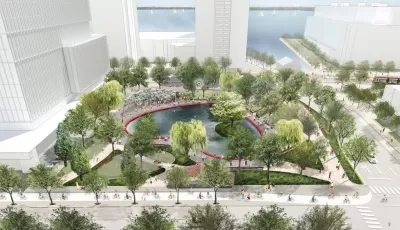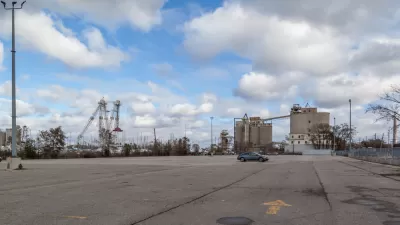In a reversal from Sidewalk Labs’ now-defunct tech-heavy proposal, Toronto’s new plan for the waterfront development known as Quayside emphasizes greenery and nature.

After the spectacular failure of Sidewalk Labs’ ambitious plan to redevelop Toronto’s waterfront into a tech utopia called Quayside, the city has a new plan that favors nature over technology, writes Karrie Jacobs in Technology Review.
The Sidewalk Labs ‘smart city’ proposal encountered opposition from the beginning. “The project’s tech-first approach antagonized many; its seeming lack of seriousness about the privacy concerns of Torontonians was likely the main cause of its demise.” As Jacobs writes, “By May 2020, Sidewalk had pulled the plug, citing ‘the unprecedented economic uncertainty brought on by the covid-19 pandemic.’ But that economic uncertainty came at the tail end of years of public controversy over its $900 million vision for a data-rich city within the city.”
Toronto hired a new design team to create a new vision for the site. “The new Waterfront Toronto project has clearly learned from the past. Renderings of the new plans for Quayside—call it Quayside 2.0—released earlier this year show trees and greenery sprouting from every possible balcony and outcropping, with nary an autonomous vehicle or drone in site.” In the new plan, Jacobs observes, “The pendulum has swung back toward Howard’s garden city: Quayside 2022 is a conspicuous disavowal not only of the 2017 proposal but of the smart city concept itself.”
The plan leaves open questions about the actual impact of its “green” infrastructure. Jacobs wonders, “How many pocket forests and neighborhood farms will it take to cool the planet?” But “Whatever its practical impact, renderings of the new version of Quayside suggest a more livable place” and a deeper understanding of what makes cities desirable places to live.
FULL STORY: Toronto wants to kill the smart city forever

Alabama: Trump Terminates Settlements for Black Communities Harmed By Raw Sewage
Trump deemed the landmark civil rights agreement “illegal DEI and environmental justice policy.”

Planetizen Federal Action Tracker
A weekly monitor of how Trump’s orders and actions are impacting planners and planning in America.

Why Should We Subsidize Public Transportation?
Many public transit agencies face financial stress due to rising costs, declining fare revenue, and declining subsidies. Transit advocates must provide a strong business case for increasing public transit funding.

Understanding Road Diets
An explainer from Momentum highlights the advantages of reducing vehicle lanes in favor of more bike, transit, and pedestrian infrastructure.

New California Law Regulates Warehouse Pollution
A new law tightens building and emissions regulations for large distribution warehouses to mitigate air pollution and traffic in surrounding communities.

Phoenix Announces Opening Date for Light Rail Extension
The South Central extension will connect South Phoenix to downtown and other major hubs starting on June 7.
Urban Design for Planners 1: Software Tools
This six-course series explores essential urban design concepts using open source software and equips planners with the tools they need to participate fully in the urban design process.
Planning for Universal Design
Learn the tools for implementing Universal Design in planning regulations.
Caltrans
Smith Gee Studio
Institute for Housing and Urban Development Studies (IHS)
City of Grandview
Harvard GSD Executive Education
Toledo-Lucas County Plan Commissions
Salt Lake City
NYU Wagner Graduate School of Public Service



























